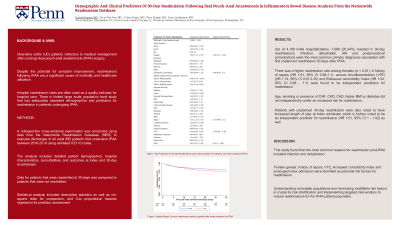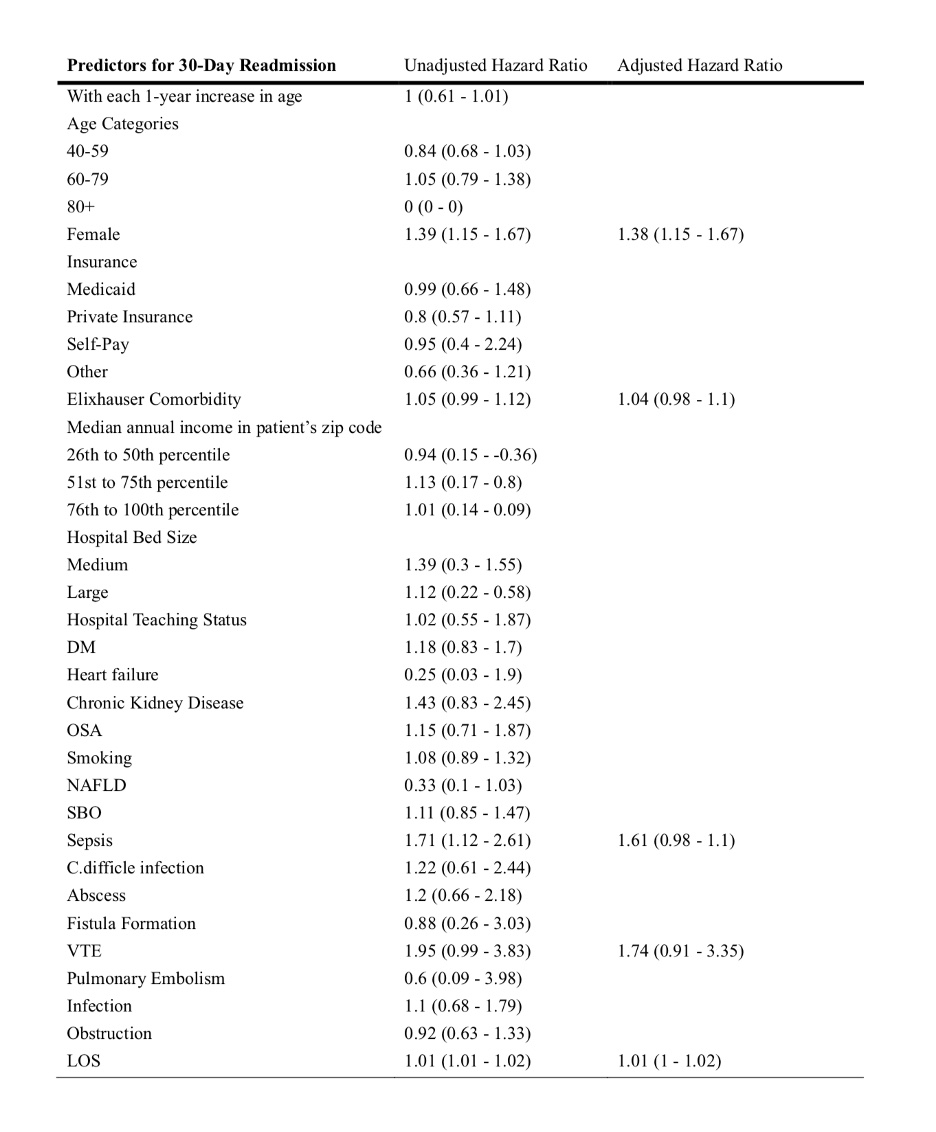Tuesday Poster Session
Category: IBD
P4294 - Demographic And Clinical Predictors Of 30-Day Readmission Following Ileal Pouch-Anal Anastomosis in Inflammatory Bowel Disease: Analysis From the Nationwide Readmission Database
Tuesday, October 29, 2024
10:30 AM - 4:00 PM ET
Location: Exhibit Hall E

- TK
Tushar Khanna, MD
Penn Medicine
Philadelphia, PA
Presenting Author(s)
Tushar Khanna, MD1, Chun-Wei Pan, MD2, Yichen Wang, MD3, Priya Sehgal, MD1, Gary Lichtenstein, MD1
1Penn Medicine, Philadelphia, PA; 2Cook County Health, Chicago, IL; 3Perelman School of Medicine at the University of Pennsylvania, Philadelphia, PA
Introduction: Ulcerative colitis (UC) patients refractory to medical management often undergo ileal pouch-anal anastomosis (IPAA) surgery. Despite the potential for symptom improvement, readmissions following IPAA are a significant cause of morbidity and healthcare utilization. Hospital readmission rates are often used as a quality indicator for hospital care, There is limited large scale population level study that has adequately assessed demographics and predictors for readmission in patients undergoing IPAA
Methods: A retrospective cross-sectional examination was conducted using data from the Nationwide Readmission Database (NRD) to evaluate discharges of all adult IBD patients that underwent IPAA between 2016-2019 using validated ICD 10 codes. The analysis includes detailed patient demographics, hospital characteristics, comorbidities, and outcomes at index and 30-day re-admission. Data for patients that were readmitted at 30-days was compared to patients that were not readmitted. Statistical analysis included descriptive statistics as well as chi-square tests for comparison, and Cox proportional hazards regression for predictor assessment
Results: Out of 4,106 initial hospitalizations, 1,086 (26.44%) resulted in 30-day readmissions. Infection, dehydration, AKI and postprocedural complications were the most common primary diagnoses associated with first unplanned readmission 30 days after IPAA. There was a higher readmission rate among females (p < 0.01). A history of sepsis (HR 1.61, 95% CI 0.98-1.1), venous thromboembolism (VTE) (HR 1.74, 95% CI 0.91-3.35) and Elixhauser comorbidity Index (HR 1.04, 95% CI 0.98 - 1.1) were found to be independent predictors for readmission. Age, smoking or presence of CHF, CKD, CAD, higher BMI or diabetes did not independently confer an increased risk for readmission. Patients with unplanned 30-day readmission were also noted to have increased length of stay at index admission which is further noted to be an independent predictor for readmission (HR 1.01, 95% CI 1 - 1.02) as well
Discussion: This study found that the most common reasons for readmission post-IPAA included infection and dehydration. Female gender, history of sepsis, VTE, increased comorbidity index and prolonged index admission were identified as potential risk factors for readmission. Understanding vulnerable populations and minimizing modifiable risk factors is crucial for risk stratification and implementing targeted interventions to reduce readmissions for the IPAA patient population.

Disclosures:
Tushar Khanna, MD1, Chun-Wei Pan, MD2, Yichen Wang, MD3, Priya Sehgal, MD1, Gary Lichtenstein, MD1. P4294 - Demographic And Clinical Predictors Of 30-Day Readmission Following Ileal Pouch-Anal Anastomosis in Inflammatory Bowel Disease: Analysis From the Nationwide Readmission Database, ACG 2024 Annual Scientific Meeting Abstracts. Philadelphia, PA: American College of Gastroenterology.
1Penn Medicine, Philadelphia, PA; 2Cook County Health, Chicago, IL; 3Perelman School of Medicine at the University of Pennsylvania, Philadelphia, PA
Introduction: Ulcerative colitis (UC) patients refractory to medical management often undergo ileal pouch-anal anastomosis (IPAA) surgery. Despite the potential for symptom improvement, readmissions following IPAA are a significant cause of morbidity and healthcare utilization. Hospital readmission rates are often used as a quality indicator for hospital care, There is limited large scale population level study that has adequately assessed demographics and predictors for readmission in patients undergoing IPAA
Methods: A retrospective cross-sectional examination was conducted using data from the Nationwide Readmission Database (NRD) to evaluate discharges of all adult IBD patients that underwent IPAA between 2016-2019 using validated ICD 10 codes. The analysis includes detailed patient demographics, hospital characteristics, comorbidities, and outcomes at index and 30-day re-admission. Data for patients that were readmitted at 30-days was compared to patients that were not readmitted. Statistical analysis included descriptive statistics as well as chi-square tests for comparison, and Cox proportional hazards regression for predictor assessment
Results: Out of 4,106 initial hospitalizations, 1,086 (26.44%) resulted in 30-day readmissions. Infection, dehydration, AKI and postprocedural complications were the most common primary diagnoses associated with first unplanned readmission 30 days after IPAA. There was a higher readmission rate among females (p < 0.01). A history of sepsis (HR 1.61, 95% CI 0.98-1.1), venous thromboembolism (VTE) (HR 1.74, 95% CI 0.91-3.35) and Elixhauser comorbidity Index (HR 1.04, 95% CI 0.98 - 1.1) were found to be independent predictors for readmission. Age, smoking or presence of CHF, CKD, CAD, higher BMI or diabetes did not independently confer an increased risk for readmission. Patients with unplanned 30-day readmission were also noted to have increased length of stay at index admission which is further noted to be an independent predictor for readmission (HR 1.01, 95% CI 1 - 1.02) as well
Discussion: This study found that the most common reasons for readmission post-IPAA included infection and dehydration. Female gender, history of sepsis, VTE, increased comorbidity index and prolonged index admission were identified as potential risk factors for readmission. Understanding vulnerable populations and minimizing modifiable risk factors is crucial for risk stratification and implementing targeted interventions to reduce readmissions for the IPAA patient population.

Figure: Predictors for 30 day Readmission in IPAA surgery.
Disclosures:
Tushar Khanna indicated no relevant financial relationships.
Chun-Wei Pan indicated no relevant financial relationships.
Yichen Wang indicated no relevant financial relationships.
Priya Sehgal indicated no relevant financial relationships.
Gary Lichtenstein indicated no relevant financial relationships.
Tushar Khanna, MD1, Chun-Wei Pan, MD2, Yichen Wang, MD3, Priya Sehgal, MD1, Gary Lichtenstein, MD1. P4294 - Demographic And Clinical Predictors Of 30-Day Readmission Following Ileal Pouch-Anal Anastomosis in Inflammatory Bowel Disease: Analysis From the Nationwide Readmission Database, ACG 2024 Annual Scientific Meeting Abstracts. Philadelphia, PA: American College of Gastroenterology.
